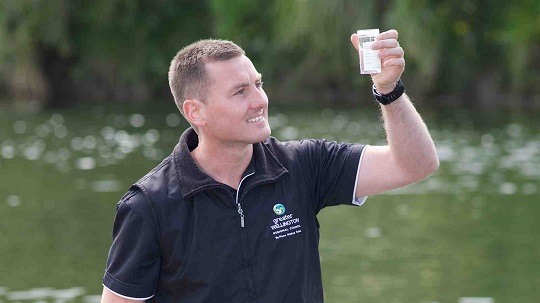Hidden danger in our rivers
Summer provides the perfect growing conditions for a potentially lethal blue-green alga that’s found in many New Zealand rivers, the subject of new research by PhD graduate Mark Heath.

Summer for most of us is a time to embrace the warmer weather, but it also provides the perfect growing conditions for a potentially lethal blue-green alga that’s found in many New Zealand rivers, and which is the subject of new research by a PhD graduate.
The alga, known as Phormidium, can produce a potent neurotoxin that’s as toxic as cobra venom. It has become increasingly prevalent in the last 10 years, and in that time has been responsible for the deaths of about 100 dogs in New Zealand. While there have been no human deaths as a result of ingesting the neurotoxin, there have been anecdotal reports of people becoming very sick after coming into contact with it.
But Mark Heath, who graduates from Victoria this week with a PhD in Ecology and Biodiversity, is trying to identify why this poisonous alga is on the increase, and what can be done to lessen its impact.
“In 2005 when five dogs died after ingesting this algae from the Hutt River, there was very little known about it internationally, and therefore very little guidance about what to do. So when I started my research as a Masters student in 2008 I tasked myself with finding out exactly what these toxic blooms were and what environmental conditions were causing Phormidium to grow.”
Over a 12 month period, Mark examined five rivers in the greater Wellington region, and found Phormidium was far more widespread than previously thought.
“The Greater Wellington Regional Council in 2005 only found Phormidium in small pockets of the Hutt River, but in 2008 I discovered the extent of proliferations had increased and were occurring throughout the river covering many kilometres of riverbed, which was obviously a big worry. So I focused on establishing whether human influences were causing the increase.”
During his PhD, Mark looked at nutrient levels in the rivers and found that the alga grew best in rivers with elevated concentrations of nitrogen and moderate to low levels of phosphorus. “This toxic alga appears to have a competitive advantage over other algal species in that it can source phosphorus from sediment, whereas other species rely on the water itself for their phosphorus source.”
He says changes in the way land is being used and managed may have a big impact on the prevalence of toxic Phormidium blooms. “In some rivers, phosphorus is being reduced through the construction of wetlands and upgrades to waste water treatment plants—such is the case in the Tukituki River in Hawke’s Bay—and it may inadvertently create favourable conditions for toxic algae development.”
Mark, who is now employed by the Greater Wellington Regional Council, says the coming warm El Niño summer will undoubtedly see the problem rear its head again. “These algal mats grow rapidly over summer when it’s warm and water flows in the rivers are lower. The toxic alga accumulates and grows, and the mats eventually slough off the rocks and get caught in the river margins. They start to decay and produce a really distinctive musty odour that dogs just love—a piece as small as a 50 cent coin can be enough to kill a 20kg dog within half an hour of eating it.
“The warmer weather is obviously also a time when people want to use the water to cool off, so there’s a real need for the public to know the risks. There’s been a big push by regional councils to raise awareness and I encourage all river users to check their respective council’s websites for the latest information on toxic algae—Wellington river users should check out the Greater Wellington Regional Council’s Summer Check website.”
Mark has received support from six regional councils across the country to complete his studies, and has also worked with academics in France who wanted to know more about why dogs and fish were dying in rivers there. “That collaboration really highlighted how little was known about this toxic alga, and how important this work is internationally,” says Mark.
